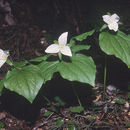en
names in breadcrumbs


Trillium ovatum, commonly known as the Western trillium, is an herbaceous monocot and a member of the Liliaceae family. It is native to the North American west coast including southern British Columbia, Washington, Oregon, and Northern California, as well as Colorado, Wyoming, Idaho, Montana, and parts of Alberta. Western trillium typically grows to a height of 10 to 20 cm. The green leaves are ovate, between
5 and 15 cm in length, and grow in a flat whorl of three under the flower (Alden 1998).The flower is white but turns pinkish or reddish as it ages. The peduncle is between 2 and 8 cm long. What makes T. ovatum unique is that the sepals grow in a whorl of three and are narrowly oblong, alternating with the three white petals of the flower. The fruit is a yellowish oval-shaped capsule with small seeds (Legler, et al 2018; Pojar and Mackinnon 2004).
This species is found exclusively in temperate climates. It thrives in soil that is pH neutral-acidic, rich in nutrients, at least partially shaded, and moist. It is a perennial with four main stages of life: cotyledon, one-leaved, three-leaved, and three-leaved with flower (Rottink 2016). It usually reaches its flowering stage during late April and will remain in this stage until June. Then the plant regresses to its “three-leaved” stage until the following spring.
T. ovatum is an edible plant and has been used in some medical practices. Its seeds and leaves are most commonly consumed. The seeds are compared to sunflower seeds. Various Native American groups have used preparations of the plant’s roots to treat afflictions of the eyes and boils on the skin (NAED 2003).
Western trillium has a symbiotic relationship with ants and an interesting association with robins. Once a trillium seed is ready to be pollinated, it produces an oil reservoir that attracts ants. The ants then carry the seed back to their nest and feed on the oil where the plant then grows.The ants use the seed to feed larvae. This is an effective mechanism for seed dispersal because ants are responsible for 30% of the spring-flowering of herbaceous plants in eastern United States forests, as well as a number of species in western forests (Pojar and Mackinnon 2004). Also, as the flower blooms in early spring, between March and May, robins start to appear. This has led to the alternative name for Trillium ovatum, which is “wake-robin,” because the flowers were thought to wake up the birds for springtime (Pojar and McKinnon 2004).